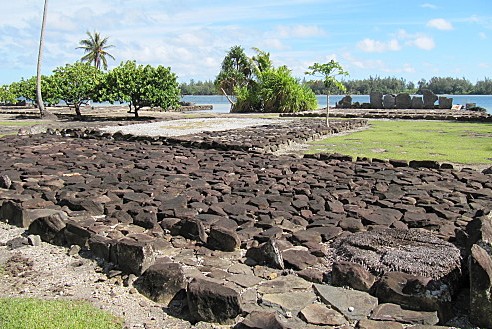What are the marae?
The marae were spaces dedicated to social and religious ancient Polynesians ceremonial activities. Some were small, including many altars called marae tupuna, family altars. Not all the marae belonged to the upper class all of ari'i, but they generally had the largest and highest marae. If the design and construction of a marae ranged from one island to another, the basic architecture generally comprised a rectangular courtyard or marae, provided a platform ('ahu) to one of its ends, and a set of standing stones.
Place of worship of ancestors and some deities, the marae was a meeting place between the people and the powers that it was important to obtain favors from. The religious ceremonies gave rise to prayers ('upu pure), invocations (ti'aorora'a) and offerings (pūpūra'a ō).

The elements of a marae
The Leeward islands marae and those of the Windward Islands showed significant architectural and ornamental differences (size, location, walls, accessories). Two components are still common: the courtyard of marae and ahu, space reserved for gods and spirits of some...-
. . . continue reading
... ancestors. The marae paving could cover all or part of the court. Most often, the Leeward islands marae does not include a stone wall, such as Tahiti). A certain number of stones, permanent elements of construction, erected along the facade of the ahu and in the courtyard, served as altar to the gods and ancestors as well as backing to the officiants. Wood constructions with various functions housed images of gods, accessories or ceremonial relics of the dead of the privileged classes. Trees associated with the marae were considered conducive to the coming of the gods.
The marae, a living structure
-
. . . continue reading
... in the opportunity to take possession of the land. After the war, it happened that the losers marae were damaged or processed by the victors, as well as genealogies attached to marae were sometimes incorporated into the new strong men, to give them oldest legitimacy of their new territories. The marae was also the place where family life important ceremonies took place (baptism and naming, weddings, funerals) of each human group, and leaders in particular
The age of the marae
-
. . . continue reading
Most marae are dated from the late fifteenth century to the end of the thirteenth century, the peak power of large chiefdoms of the Society Islands. In Huahine as elsewhere, before the onset of monumental marae, with a courtyard and an altar, as we know, simpler places of worship existed, comprising one or more main stones that have been incorporated into the new types of marae as and when they evolved. The lakeside Fā'una nui marae around the fare pote'e are Ro'i Fare, Fare Tai, Vai-'ōtaha, Rauhuru.
